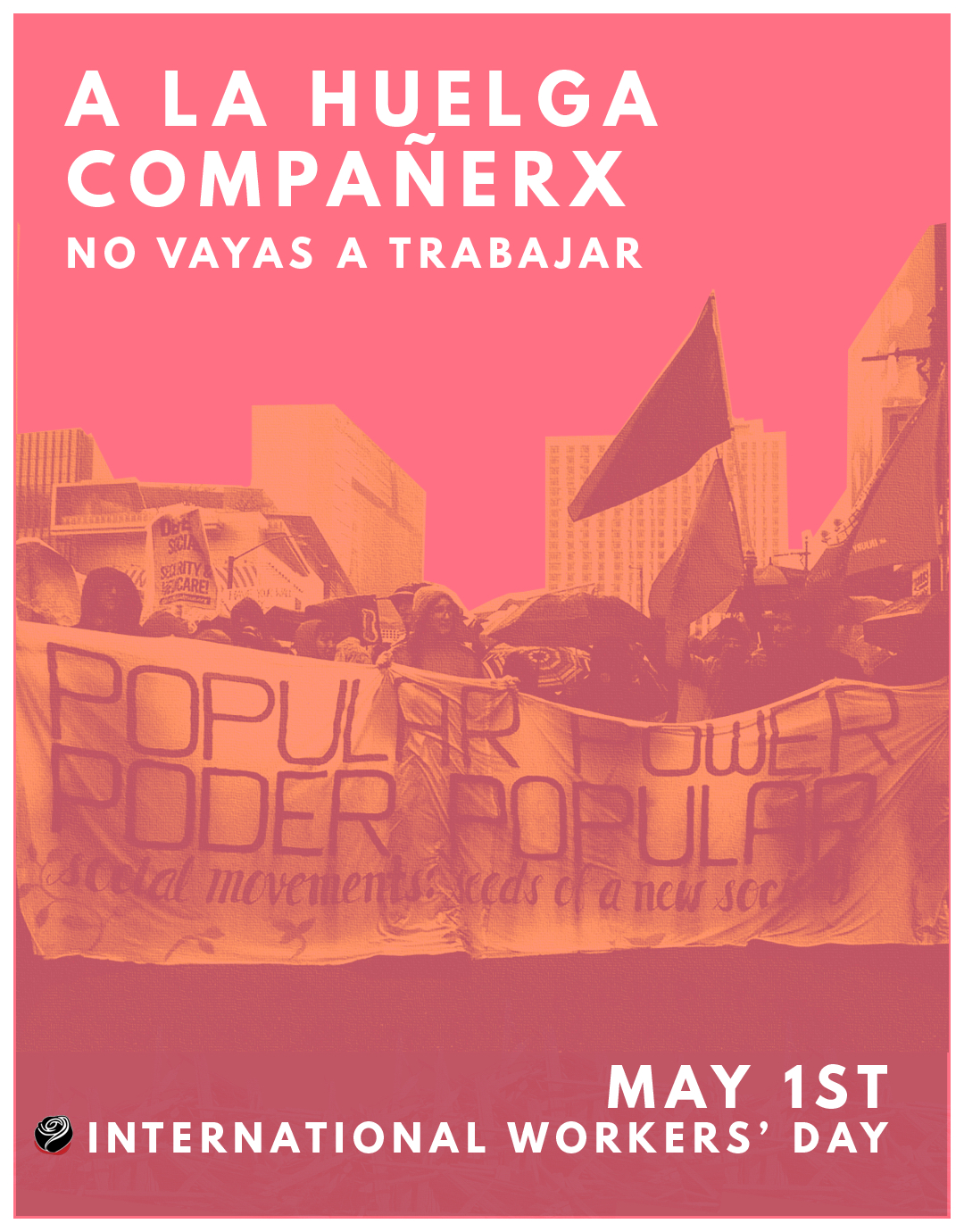
A May Day statement from Black Rose/Rosa Negra Labor Sector Committee
Versión Español haga aqui.
After a ruthless “first 100 days” of reaction from the Trump regime, including escalating attacks on immigrants, open season for capitalists, bombing campaigns, and the looming threat of a new “law and order,” we stand in solidarity with those taking to the streets for May Day across the country and around the world.
Since the election of Donald Trump, many people have been asking what they can do to fight back. On May Day, International Workers Day, one place to look is where many of us spend the bulk of our day: the workplace. This May Day gives us an opportunity to draw inspiration from recent worker and immigrant struggles, bring our co-workers together into collective action against the current right-wing onslaught, and continue to build the solidarity, organization, and popular power needed for a new revolutionary labor movement.
Although the number of workers participating in workplace actions against the Trump regime has been relatively small, the fact that any group of workers is willing to take such risks in standing together to fight for political demands – as opposed to the more narrow economic demands of improved wages and working conditions — is significant. To give a picture of what these actions have looked like, we want to share some of the experiences of friends and comrades who have participated in strikes against Trump:
Teacher, Public High School in New York:
Our union decided to walk out of school on Women’s Day. The plan was based on what some of the more reluctant members of our union said they would be comfortable with. This was that we would walk out at the end of the day, during seminar, and we would just shut school for the last 45 minutes of the day. Plus, we missed all of our professional development.
Our profession is heavily gendered as female, and there are five male teachers total at our entire school. So that connection was pretty obvious to people, but there were no concrete demands that we were organized around, just this general sense that women’s rights are under attack, that women are doing powerful things when they act together, and that we have to stand up for our students.
We designed this amazing lesson plan for those 45 minutes where the five male teachers plus the administration would guide students through thinking about what gender inequality is, and how it’s important for us to teach the responsibility to engage in struggle and fight injustice. We called on the men at our job to basically take on the role of educating students about gender inequality. So those pieces all felt really good, but then at the end of the day the most moderate members of our union did not participate either way. They just quietly did not show up.
And then for the teachers who left we marched around in front of the school for a while and then we took the subway downtown to join the Women’s Day rally.
I think that there was very little actual building up to this – very little actually saying how is this going to change anything, why this action, what exactly are we fighting for on this day. If we had done that, who knows what kind of participation we could have achieved. You can’t manufacture a strike out of nothing.
I think that the point is to take action collectively, as much as possible, and that means actually organizing people, actually having organizing conversations with people about why to take this action. Not just asking “what are you willing to do?”, but showing people what, concretely, we’re trying to achieve, and how these actions are part of strategy to build something bigger and more powerful, not just a cycle of repeating the same thing over and over again.
Medical Assistant, Community Health Center in Boston:
I’m an immigrant from El Salvador and the majority of my coworkers are immigrant women from various countries such as Honduras, Haiti, the Dominican Republic, Puerto Rico, the Philippines, Morocco and Nepal. We are all exploited as workers, and also as immigrants we are affected by the Trump administration’s attacks. For that reason I decided to participate in the Asamblea del Pueblo, a new organization that is dedicated to defending the immigrant community against deportations and everyday racism. We have been meeting almost weekly since last November’s election. When thousands of workers across the US struck for the “Day without Immigrants” in February, we organized a rally and assembly where we offered support to workers who faced retaliation from their bosses for participating in the strike. I have focused on inviting my co-workers to join the assemblies. Many of them have asked me “why organize like that?” and I tell them that we know best what our problems are and what are real solutions to our problems. Besides the work I’m doing with Asamblea del Pueblo, several months ago I joined the Industrial Workers of the World (IWW), a combative and democratic union. One day I want us to be organized in our workplace, although I know that that will take time and effort. I am patient, but this May Day I will be on strike.
Graduate Student Instructor, UC San Diego in California:
On January 20, 2017, students and workers on our campus refused to work in protest of Donald Trump’s inauguration to office of the presidency. Faculty, staff, TAs, and students spent three months planning for the strike. Weekly meetings took place with 50+ participants, all of whom took on active and essential roles in the organizing efforts. We began the strike action by blocking the faculty parking lot with our picket line, preventing fellow instructors from arriving to our workplace and subsequently prohibiting the everyday functioning of our university. We then gathered for a rally at noon, where over 600 people gathered for speeches, later to break into a spontaneous dance party in the midst of the pouring rain.
Through this experience, I was able to forge new relationships grounded in solidarity and shared interests as students and workers. In organizing collective action together with my peers, my friends, I felt empowered to change my relationship with my workplace, thus challenging my everyday conditions of oppression, my exploitation.
While these stories only gives us a glimpse of recent labor militancy, the current atmosphere points to future opportunities for expanding the terrain of struggle. We need to move beyond the relatively small scale, dispersed, and disconnected state of current actions, which mostly revolve around public sector workplaces with low risk of retaliation, toward broad-based, cross-sector coordinated strikes and workplace mobilizations that include private sector, low wage and unwaged workers.
While there are real limits to mobilizations such as May Day, at the workplace level they provide opportunities to continue the work that the stories above demonstrate – the work of building relationships with our co-workers, growing political consciousness and militancy, and making connections with other struggles to rebuild a fighting labor movement. In other words, the specific action that happens matters less than the political transformation and organization it creates or cultivates.
But action in the workplace needs a goal beyond just the immediate step of politicizing and organizing with our co-workers. These are short-term gains that don’t by themselves answer the necessary question of how we are going to survive on a planet being throttled by capitalism. We are taking action on May Day with the ultimate goal of the revolutionary overthrow of capitalism and the state, and the dismantling of white supremacy and heteropatriarchy. On May Day, as with all our actions, we should be asking ourselves: how do our actions connect to our ultimate goals? To create a new society requires building revolutionary social movements with the power to break the chains of capital and social oppression as well as the vision and organization to build a new world from the bottom up.
For some workers in the US, a promising tool for building that movement is the Industrial Workers of the World (IWW). Given the steady decline of union membership over the years, most workplaces and industries have little or no union presence. Or in the case of stay-at-home-parents, sex workers, and those incarcerated in the massive prison system, most unions do not recognize these groups as workers. In the face of a union movement on the wane and out of the desire to create a revolutionary pole within the broader labor movement, workers have joined the IWW in increasing numbers since the economic crisis of 2008. In addition to its modest growth, the IWW’s recent activity among service workers, prison labor, and anti-fascist organizing points toward the kind of labor movement that is needed in this moment.
Despite declining numbers, millions of workers are still members of existing unions that should not be ignored. While we have no illusions about transforming mainstream unions into vehicles for liberation, we support efforts to develop rank and file tendencies that are independent of the leadership and committed to building struggle in and outside of the workplace. Regardless of the method or organization, our task is to build a combative, worker-controlled, and class struggle oriented labor movement.
When we talk with our co-workers about May Day, about the reasons why thousands of workers will be taking to the streets, when we assert our collective power by disrupting profit-making and exploitation, individuals are transformed into a conscious fighting force – they become aware of their strength and role in the fight for a new world. It’s these small acts that deepen the struggles and consciousness of a militant and independent working class.
